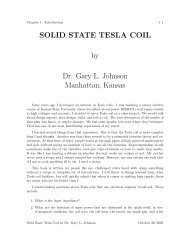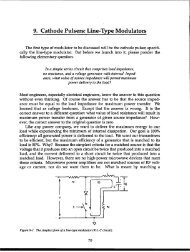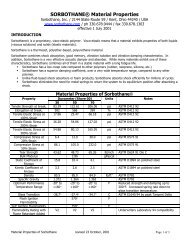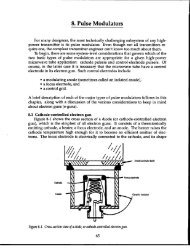3.6M north10.pdf - Dean-O's Toy Box
3.6M north10.pdf - Dean-O's Toy Box
3.6M north10.pdf - Dean-O's Toy Box
Create successful ePaper yourself
Turn your PDF publications into a flip-book with our unique Google optimized e-Paper software.
178 High-Power Microwave-Tube Transmitters<br />
+400<br />
A. Measured Constant-Current Tube Characteristics<br />
(1.5 kV screen voltage)<br />
B. Predicted Constant-Current Tuba Characteristics<br />
(7S0 V screen Wtage)<br />
+2U0<br />
‘x<br />
+150<br />
+100<br />
1,= 141 A<br />
i<br />
IP=250A<br />
z ‘w<br />
?$<br />
GO<br />
)0 -Q<br />
g<br />
-50<br />
-1oo<br />
Currenls ara changed in proportbn to<br />
(ratkl of Scrssn vollages)~<br />
-300<br />
-150 ~.-l<br />
___.L,.._,_J<br />
o 1 2 34 5 6 0 0.5 1.0 1.5 2.0 2.5 3.0<br />
Imode voltage (kV) Ads voltage (W)<br />
Figure 10-22. Transiting tetrode voltage/current characteristics for dl~erent screen voltages.<br />
line. To the left of this line screen current dominates anode current, and screen<br />
dissipation becomes excessive. The top segment is the maximum anode current<br />
limit. The curved-line limit is the actual anode dissipation, beyond which the<br />
product of anode voltage and current exceeds 2 MW. The right-hand line, which<br />
rises from the 30-kV anode voltage, is a limit on electron energy, or velocity,<br />
beyond which electrons will penetrate the anode and cause damage.<br />
The voltage/current characteristics of tetrodes, in general, are more cumbersome<br />
to illustrate because there are four degrees of freedom compared to only<br />
three in the triode. This means that there is a unique set of data interrelating<br />
anode and grid voltages with anode, grid, and screen currents for each and every<br />
value of screen voltage. Manufacturer’s published data will rarely show more<br />
than two such screen voltages. Even if no more than one is given, however, it is<br />
possible to synthesize the appropriate data points needed for any other value of<br />
screen voltage. How this is done is shown in Fig. 10-22. The manufacturer’s<br />
information given in Fig. 10-22a and is based on constant-current characteristics<br />
for 1500-V screen voltage. But what is wanted is the same data for a screen<br />
voltage of 750 V. To derive this information, a new set of axes along with new<br />
grid voltage and anode voltage must be generated. In this case, the ratio of 750 V<br />
to 1500 V is 1/2. The original current values for grid, screen, and anode are all<br />
multiplied by the transfer ratio 1/2 raised to the 3/2 power. In the example<br />
shown, the original 250-A anode-current line becomes in Fig. 10-22b 250A x (1/<br />
2)32, which is 86 A, and the original 400-A line becomes the 141-A line by the<br />
same process. Meanwhile the 25-A screen-current line becomes the 8.8-A line<br />
and the 3-A grid-current line becomes a 1.06-A line. An entire characteristic can<br />
be translated, but plotting only a few points at the full-conduction and cutoff<br />
ends usually suffices because we are using these devices primarily as switches.







